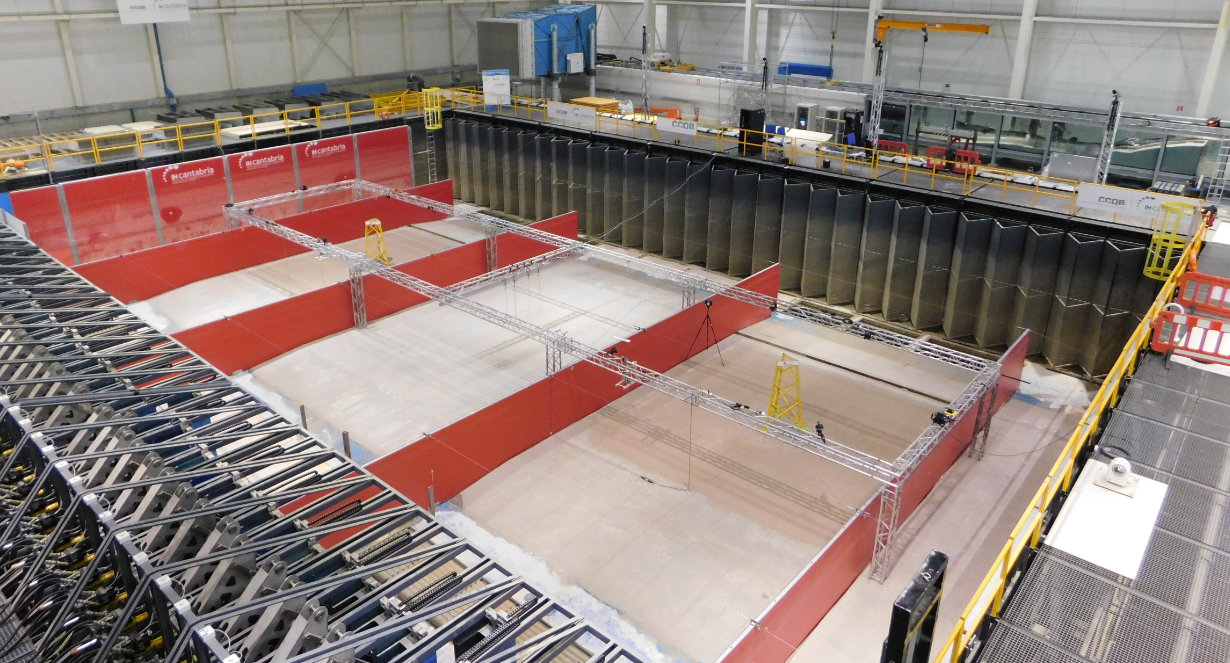IHCantabria contributes to the development of anti-scour protection systems for marine structures, with SOCAVA

The SOCAVA project consolidates IHCantabria as a key player in the study of fluid-structure-terrain interaction, thanks to a novel experimental strategy that allows it to develop tests on a scale unique in Europe.
SOCAVA is a research project of the Institute of Environmental Hydraulics of the University of Cantabria (IHCantabria), which aims to develop a pioneering methodology to analyze scour around fixed offshore structures on the seabed. This project is part of the Marine Science Programme of this institute and its execution period is two years, from June 2023 to June 2025.
The development of large offshore wind farms depends on the correct performance of unique structures such as offshore substations. These structures are characterized by their criticality, not only for housing electrical equipment of great responsibility, but also for being structures of enormous complexity installed in environments of great hostility and severity such as the marine environment. Its interaction with currents and waves can lead to the development of scour processes that can compromise its stability and therefore its operation, which is critical for the correct functioning of a wind farm.
The multidisciplinary approach of the SOCAVA project stands out because through the integration of experimental, numerical and semi-empirical techniques it aims to deepen the evaluation of scour processes around critical structures, such as electrical substations. Its integrated approach will make it possible to determine the need and optimization of anti-cavitation protections, with the aim of improving the competitiveness of a very relevant player in the future international energy mix, such as offshore wind power.
SOCAVA project objectives and scope
At the heart of this project is the motivation to solve a challenge that has persisted since the installation of the first offshore wind farms. This is scour, a complex phenomenon resulting from the interaction between fluids and marine structures.
Usually, the complexity of these phenomena forced to perform analyses based on reduced experimental tests, in wave-current tanks, but the SOCAVA project allows for more accurate tests, overcoming the limitations of current methods, in addition to promoting learning from lessons learned and the development of an innovative strategy for the analysis and protection of offshore structures.
Methodology and projection of results
The SOCAVA project aims to validate a comprehensive methodology where, through the application of semi-empirical solutions, state-of-the-art numerical models and experimental techniques in large-scale test laboratories, it is possible to design, validate and optimize protection solutions compatible with complex structures.
The aim of SOCAVA is to “position IHCantabria as a benchmark in the analysis and prevention of scour around complex structures on the seabed,” explains Raul Guanche Garcia, head of the Offshore Engineering and Marine Energy Group at IHCantabria. He is one of the principal investigators of this project, together with Javier Sarmiento Martinez, a senior researcher specializing in this field of engineering. Alvaro Alvarez Vazquez, who is responsible for the Hydraulics, Coastal and Offshore Laboratory at IHCantabria, collaborates with them in this project.
One of the expected results of the SOCAVA project is the development of a proprietary database to establish robust semi-empirical approaches for understanding and preventing scour in various marine structures.
This project is closely aligned with Sustainable Development Goal 7, because it seeks not only to improve IHCantabria’s scientific-technical competitiveness, but also to contribute to guaranteeing universal access to affordable, safe and sustainable energy, in order to improve the living conditions of millions of people.




